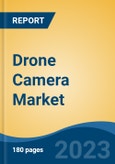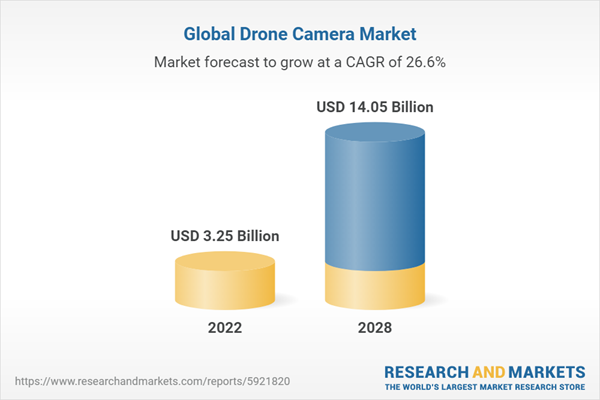Speak directly to the analyst to clarify any post sales queries you may have.
10% Free customizationThis report comes with 10% free customization, enabling you to add data that meets your specific business needs.
Key Market Drivers
Rising Defense Budgets of Government Bodies to boost the market growth
The introduction of technologically improved goods and the drone market's favorable growth rate are the main factors propelling the growth of the drone camera market. However, there is a market opportunity due to the growing demand for drones in emerging nations. The drone camera market has seen a significant amount of technological development. One of the most important incremental market developments is miniaturization.More effective trade-offs between the drone and its maximum payload, flying range, and maximum altitude are made possible by adopting lighter, more efficient batteries and innovative materials. The second significant trend in the market is the increase in drone autonomy. The application of cutting-edge technology, like autonomous operations, where the use of a human operator for remote drone control is partially or entirely excluded. Most commercially available drones are operated remotely and include some autonomy features, such as stabilizing software. Pre-planned flights are available with professional drones. It is projected that in the coming years, autonomy will be used increasingly to identify and avoid systems, plan flight routes for conducting evasive maneuvers like airplanes and birds, and adjust to defensive reactions when under attack and changing weather conditions. The innovation is the swarming of drones that can function as sensor networks. Therefore, rising defense and military applications have recently enhanced the Drone Camera market CAGR globally.
Significant drivers influencing market revenue growth include the growing accessibility and affordability of drones, the expansion of the applications for GPS, inspection and mapping services, and LiDAR, as well as the increasing demand for aerial photography and cinematography. Drones are more dependable, especially in security management, because they are quicker, cheaper, and capable of greater heights than conventional airborne monitoring systems. Providing live photos and videos to operational centers also fuels the market's revenue growth. Aiding in risk mitigation procedures will increase Drone Camera market revenue.Drone Camera Market Segment Insights:Drone Camera Resolution InsightsBased on the resolution, the Drone Camera Market segmentation includes 12 MP, 12 to 20 MP, 20 to 32 MP, and 32 MP & Above. 32 MP and above segment held the majority share in 2022 contribution to around ~45-47% concerning the Drone Camera Market revenue. Drones with 32 MP or higher quality cameras are typically employed for security and defense operations. These drones monitor suspicious places and give detailed information about what is done there. They have transitioned to UAVs with cutting-edge components like high-resolution cameras and navigation systems due to growing national safety and security concerns and increased budgetary allocations in the defense industry.
Key Market Challenges
The primary challenge in the global drone camera market is the complex and ever-evolving regulatory and legal landscape governing the use of drones, particularly those equipped with cameras. These regulations are imposed by various government bodies, aviation authorities, and local agencies, and they vary significantly from one region to another. The challenges posed by regulatory and legal hurdles are multifaceted, impacting different aspects of the industry.The primary reason behind drone regulations is safety. Drones equipped with cameras can pose risks to people, property, and other aircraft. Incidents involving near misses, unauthorized overflights, and privacy breaches have raised concerns, leading to stricter regulations. Strict regulations are necessary to mitigate safety risks and prevent accidents, but they can limit the operational flexibility of drone operators.
Privacy Issues: Drones equipped with cameras have the potential to invade individuals' privacy, as they can capture images and videos of people without their consent. This raises ethical and legal concerns, leading to regulations that aim to protect individuals' privacy rights.
Implication: Privacy regulations can restrict the use of drone cameras in certain applications, such as aerial photography, and may require operators to obtain consent from property owners or individuals in the vicinity.
Airspace Management: Drones share the airspace with manned aircraft, and effective airspace management is crucial to prevent collisions and ensure safe coexistence. Regulations aim to establish airspace zones and altitude restrictions for drones.
Implication: Strict altitude restrictions can limit the capabilities of drone cameras, particularly in applications requiring higher altitudes for data collection or aerial photography.
Remote Identification: Regulations often mandate the implementation of remote identification technologies for drones. This allows authorities to identify and track drones in real time, enhancing accountability and security.
Implication: While remote identification is essential for security, its implementation can be costly and complex for drone manufacturers and operators.
No-Fly Zones: Certain areas are designated as no-fly zones, such as airports and sensitive government facilities, to prevent interference with manned aircraft and ensure national security.
Implication: No-fly zones can restrict drone camera use in specific regions, posing challenges for applications like surveying or inspections near these areas.
Compliance Costs: Meeting regulatory requirements and obtaining necessary permits can be costly for both manufacturers and drone operators. This includes expenses related to safety features, certifications, and pilot licenses.
Implication: Compliance costs may deter small businesses and startups from entering the market or expanding their operations, limiting innovation and growth.
International Variability: The global nature of the drone camera market means that regulations vary significantly between countries. This inconsistency can create challenges for companies operating on an international scale.
Implication: Adhering to varying regulations in different countries can increase complexity and compliance costs for global drone camera manufacturers and service providers.
Evolving Regulations: Drone regulations are continually evolving as governments respond to emerging issues and technological advancements. Keeping up with changing rules and ensuring compliance is an ongoing challenge.
Implication: Businesses must invest in staying informed about evolving regulations and adapt their operations accordingly, which can be time-consuming and resource-intensive.
Public Perception: Negative incidents involving drones, such as accidents, privacy breaches, and noise disturbances, can influence public opinion and lead to calls for stricter regulations.
Implication: A negative public perception of drones can result in more stringent regulations and reduced public acceptance of drone-related services.
Solutions and Mitigations
Addressing the regulatory and legal challenges in the global drone camera market is essential for its continued growth and success. Several strategies and solutions can help mitigate these challenges:Industry Collaboration: Drone manufacturers, industry associations, and regulatory bodies can work together to develop and implement standardized safety and operational procedures. Collaborative efforts can lead to more consistent and manageable regulations.
Public Education: Educating the public about the benefits and responsible use of drones can improve public perception. This can be achieved through awareness campaigns and community engagement initiatives.
Technological Solutions: Advancements in technology can address some regulatory concerns. For instance, the development of geofencing technology can help enforce no-fly zones and altitude restrictions.
Remote Identification: Implementing remote identification technology can enhance accountability and security. However, industry stakeholders should work with regulators to ensure that the technology is practical and affordable for manufacturers and operators.
Data Privacy Measures: Drone operators can implement data privacy measures, such as onboard data encryption and secure storage, to protect the privacy of individuals captured by drone cameras.
Key Market Trends
The Drone Camera industry is anticipated to develop in the following years due to major market players investing in new products. Businesses in the industry are also launching new products, signing agreements, increasing investments, and collaborating with other businesses as part of their market developments to broaden their global presence.The market leaders in the global Drone Camera industry are offering their products at a reduced price by reducing their operating costs by manufacturing in regional manufacturing bases. The Drone Camera market major player such as Sony Corporation (Japan), Panasonic Corporation (Japan), GoPro Inc. (US), Canon Inc. (Japan), FLIR Systems Inc. (US), and others are working on expanding the market demand by investing in research and development activities.Sony Group Corporation is an international conglomerate company with its headquarters in Minato, Tokyo, Japan. Being a significant player in the technology industry, it serves as one of the biggest consumer and business electronics producers, the most significant console maker, and the biggest publisher of video games. With Sony Entertainment, it is one of the giant music corporations (largest music publisher and second-largest record label) and one of the most prominent media organizations, thanks to its third-largest film studio. It is Japan's most prominent media and technology company. With net cash reserves of 2 trillion yen, it is also acknowledged as the most cash-rich Japanese business.Segmental Insights
Resolution Insights
32 MP and above segment held the majority share in 2022 contribution to around ~45-47% concerning the Drone Camera Market revenue. Drones with 32 MP or higher quality cameras are typically employed for security and defense operations. These drones monitor suspicious places and give detailed information about what is done there. They have transitioned to UAVs with cutting-edge components like high-resolution cameras and navigation systems due to growing national safety and security concerns and increased budgetary allocations in the defense industry.Regional Insights
North America Drone Camera market accounted for USD 5.1 billion in 2022 and is expected to exhibit a significant CAGR growth during the study period. This is due to the quick adoption of cutting-edge technologies and high-value investments, particularly by the military and defense sectors. The Federal Aviation Agency (FAA) claims drone flight is permitted in the United States. Other factors influencing the market's revenue growth in this region include favorable FAA-issued legislation, a sizable potential for research and innovation originating in tech hubs like Silicon Valley, and a dense drone ecosystem.Europe Drone Camera market accounts for the second-largest market share during the forecast period. This is brought on by a growing need for drones to assess infrastructure, sample oil, monitor oil spills, carry medical supplies through the air, and grow regulatory backing. As of January 1, 2021, the European Union Aviation Safety Agency will have uniformed drone legislation throughout its member states. Further, the Germany Drone Camera market held the largest market share, and the UK Drone Camera market was the fastest-growing market in the European region
Report Scope:
In this report, the Global Drone Camera Market has been segmented into the following categories, in addition to the industry trends which have also been detailed below:Global Drone Camera Market, By Type:
- SD Camera
- HD Camera
Global Drone Camera Market, By End User:
- Commercial
- Military
- Homeland security
Global Drone Camera Market, By Application:
- Photography & Videography
- Thermal Imaging
- Surveillance
Global Drone Camera Market, By Resolution:
- 12 MP
- 12 to 20 MP
- 20 to 32 MP
- 32 MP & Above
Global Drone Camera Market, By Region:
- North America
- United States
- Canada
- Mexico
- Asia-Pacific
- China
- India
- Japan
- South Korea
- Indonesia
- Europe
- Germany
- United Kingdom
- France
- Russia
- Spain
- South America
- Brazil
- Argentina
- Middle East & Africa
- Saudi Arabia
- South Africa
- Egypt
- UAE
- Israel
Competitive Landscape
Company Profiles: Detailed analysis of the major companies presents in the Global Drone Camera Market.Available Customizations:
Global Drone Camera Market report with the given market data, the publisher offers customizations according to a company's specific needs.This product will be delivered within 1-3 business days.
Table of Contents
Companies Mentioned
- Garmin Ltd.
- Canon Inc
- Aerialtronics DV B.V.
- GoPro, Inc.
- Sony Corporation
- DST CONTROL
- DJI
- Controp Precision Technologies Ltd
- FLIR Systems, Inc.
- Panasonic Corporation
Table Information
| Report Attribute | Details |
|---|---|
| No. of Pages | 180 |
| Published | November 2023 |
| Forecast Period | 2022 - 2028 |
| Estimated Market Value ( USD | $ 3.25 Billion |
| Forecasted Market Value ( USD | $ 14.05 Billion |
| Compound Annual Growth Rate | 26.6% |
| Regions Covered | Global |
| No. of Companies Mentioned | 10 |









